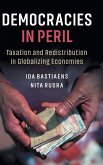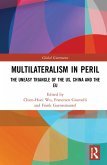- Gebundenes Buch
- Merkliste
- Auf die Merkliste
- Bewerten Bewerten
- Teilen
- Produkt teilen
- Produkterinnerung
- Produkterinnerung
This insightful text rigorously examines and accounts for contemporary developments - and crucially a reversal of 'democraticness' - in democratic polities and related political processes comparing 38 democracies across the world. The focus is on contemporary developments and recent volatile levels of democraticness.
Andere Kunden interessierten sich auch für
![Democracies in Peril Democracies in Peril]() Ida BastiaensDemocracies in Peril89,99 €
Ida BastiaensDemocracies in Peril89,99 €![Multilateralism in Peril Multilateralism in Peril]() Multilateralism in Peril180,99 €
Multilateralism in Peril180,99 €![Blowback Blowback]() Miles TaylorBlowback22,99 €
Miles TaylorBlowback22,99 €![The Protectionist Peril The Protectionist Peril]() George Herbert PerrisThe Protectionist Peril26,99 €
George Herbert PerrisThe Protectionist Peril26,99 €![Between Possibility and Peril Between Possibility and Peril]() Chris KendallBetween Possibility and Peril63,99 €
Chris KendallBetween Possibility and Peril63,99 €![The Peril of the Republic The Peril of the Republic]() Daniel Chauncey BrewerThe Peril of the Republic36,99 €
Daniel Chauncey BrewerThe Peril of the Republic36,99 €![The Coming Peril The Coming Peril]() Maris Blair CoanThe Coming Peril30,99 €
Maris Blair CoanThe Coming Peril30,99 €-
-
-
This insightful text rigorously examines and accounts for contemporary developments - and crucially a reversal of 'democraticness' - in democratic polities and related political processes comparing 38 democracies across the world. The focus is on contemporary developments and recent volatile levels of democraticness.
Produktdetails
- Produktdetails
- Verlag: Routledge
- Seitenzahl: 278
- Erscheinungstermin: 19. Dezember 2023
- Englisch
- Abmessung: 240mm x 161mm x 20mm
- Gewicht: 584g
- ISBN-13: 9781032029900
- ISBN-10: 1032029900
- Artikelnr.: 69029953
- Herstellerkennzeichnung
- Libri GmbH
- Europaallee 1
- 36244 Bad Hersfeld
- gpsr@libri.de
- Verlag: Routledge
- Seitenzahl: 278
- Erscheinungstermin: 19. Dezember 2023
- Englisch
- Abmessung: 240mm x 161mm x 20mm
- Gewicht: 584g
- ISBN-13: 9781032029900
- ISBN-10: 1032029900
- Artikelnr.: 69029953
- Herstellerkennzeichnung
- Libri GmbH
- Europaallee 1
- 36244 Bad Hersfeld
- gpsr@libri.de
Hans Keman is Professor Emeritus of Comparative Political Science at the Vrije Universiteit Amsterdam (VU Amsterdam), the Netherlands.
List of tables
List of figures
List of boxes
Preface
1 Prologue: democracy in the 21st century
1.1 Democracies in peril: backsliding and de-democratisation
1.2 The concept of democraticness: proto-types
1.3 Levels of democraticness: the yard-stick for comparison
1.4 The storyline as a "road trip": democratisation and political decay
1.5 Value-free and value-related knowledge: a realist position
PART 1
Studying democracy: detecting flaws, defects and perils
2 Reversing trends in "democraticness"
2.1 Democracy in peril?
2.2 Are "full" democracies indeed reverting?
2.3 Full democracies in contrast to flawed and defective democracies
2.4 Perilous developments: potential reasons and questions to ask
3 Comparative political science and the study of democracy
3.1 The academic debate: room for improvement
3.2 Omissions in the study of democratic politics
3.3 Comparing democratic states: full, flawed and defective polities
4 Thinking about democracy: the origins of the liberal model
4.1 From ideas to design
4.2 The enlightenment and the concept of the democratic state
4.3 John Stuart Mill and liberal democracy
4.4 The roots of liberal democracy laid out: still work in progress
PART 2
Pathways towards liberal Democratisation
5 Designing liberal democracy: institutionalising the polity
5.1 Constitutional trajectories toward "representative" governance
5.2 Missing dimensions, institutional progress and constraints
5.3 The shaping of the polity towards liberal democracy
5.4 Considerations on the road to liberal democratisation
6 Towards universal suffrage and representation of the people
6.1 Electoral inclusiveness and fair representation
6.2 Finding the optimal solution to fair and effective representation
6.3 The effects of electoral systems: inclusiveness and pluriform
representation
6.4 Institutional engineering: the choice of an optimal electoral system
7 Who governs at the end of the day in a democracy?
7.1 Power distribution and indirect democracy: inevitable or containable?
7.2 Democracy and selected leadership: the role of political elites
7.3 Indirect democracy: selecting accountable leadership
7.4 Elitism versus pluralism: power concentration or dispersion?
7.5 The scope and limits of liberal democracy
PART 3
Contemporary approaches to the development of democracy 97
8 Polyarchy and pluralism: waves of democratisation
8.1 Polyarchy: the route to "full" democracy?
8.2 Pathways of democratisation: sequences towards polyarchy
8.3 Waves of democratisation: path dependencies and critical junctures
8.4 The second wave of democratisation and reversal (1920-1939)
8.5 Post-war waves towards polyarchy and beyond
8.6 Conceptual considerations on polyarchy
9 Consensus democracy: the alternative to polyarchy?
9.1 Cleavage theory and the coming about of consensus democracy
9.2 Institutional engineering a peaceful polity: consensus democracy
9.3 Consensus democracy and a better and kinder society
9.4 Considerations on the theory of consensus democracy
10 Parties and democracy: does politics matter?
10.1 Politics - polity - policy and democracy
10.2 Complexities of democracy: political parties and policy performance
10.3 Electoral politics and parties in competition and government
10.4 To what extent does democratic politics matter?
PART 4
The liberal model as a yardstick of full democracy?
11 Ranking the stars of democraticness
11.1 The end of history or political decay?
11.2 Liberal democracy: the paradigm to follow? Ranking the stars
11.3 The state of democracy in the 21st century
11.4 Towards fuller democracies or the end of the liberal model?
12 The limits of the liberal democratic model
12.1 From liberal to full democracy? Variations of democraticness
12.2 The paradigm of liberal democracy contested: toward a fuller
democracy?
12.3 Challenging liberal democracy: reforming the system
12.4 The state of the liberal model: embeddedness or moving away?
12.5 The limits to liberal democracy
13 Signs of backsliding: illiberalism and populism
13.1 "Illiberalism" and "anti-pluralism" and the level of democraticness
13.2 Anti-pluralism and the impact of populism
13.3 The growth of anti-democratic tendencies: illiberalism and populism
13.4 Backsliding towards defective democracy
PART 5
Liberal democracy, the national state and governing society
14 Macro-politics and micro-performance of the "state"
14.1 The problem-solving capability of the democratic state
14.2 Public policy formation: political choice and policy performance
14.3 Trust is hard to gain but easy to lose: output legitimacy
15 Liberal democracy, legitimacy and stateness: micro performance
15.1 Democratic politics, public policy and societal performance
15.2 The crisis-solving capacity of democratic state: coping with a
pandemic
15.3 Avoiding misery, inequalities and the pursuit of happiness?
15.4 The democratic advantage and effective stateness as a sine qua non
16 Legitimacy and the liberal democratic state in the 21st century
16.1 Democracy and the state: entering a new age
16.2 Trust and confidence in institutions
16.3 The rise of social media and its role in politics and society
16.4 The battle for the people: mainstream party politics in disregard
16.5 The shift to provocative parliamentarism: harbouring populist
illiberalism
17 Epilogue: backsliding into the 21st century: outmoded or viable and
resilient?
17.1 Liberal democracy: state of affairs
17.2 Fear for autocratisation: institutional decay and anti-democratic
ethos
17.3 Positive conditions and negative consequences of democraticness
Index
List of figures
List of boxes
Preface
1 Prologue: democracy in the 21st century
1.1 Democracies in peril: backsliding and de-democratisation
1.2 The concept of democraticness: proto-types
1.3 Levels of democraticness: the yard-stick for comparison
1.4 The storyline as a "road trip": democratisation and political decay
1.5 Value-free and value-related knowledge: a realist position
PART 1
Studying democracy: detecting flaws, defects and perils
2 Reversing trends in "democraticness"
2.1 Democracy in peril?
2.2 Are "full" democracies indeed reverting?
2.3 Full democracies in contrast to flawed and defective democracies
2.4 Perilous developments: potential reasons and questions to ask
3 Comparative political science and the study of democracy
3.1 The academic debate: room for improvement
3.2 Omissions in the study of democratic politics
3.3 Comparing democratic states: full, flawed and defective polities
4 Thinking about democracy: the origins of the liberal model
4.1 From ideas to design
4.2 The enlightenment and the concept of the democratic state
4.3 John Stuart Mill and liberal democracy
4.4 The roots of liberal democracy laid out: still work in progress
PART 2
Pathways towards liberal Democratisation
5 Designing liberal democracy: institutionalising the polity
5.1 Constitutional trajectories toward "representative" governance
5.2 Missing dimensions, institutional progress and constraints
5.3 The shaping of the polity towards liberal democracy
5.4 Considerations on the road to liberal democratisation
6 Towards universal suffrage and representation of the people
6.1 Electoral inclusiveness and fair representation
6.2 Finding the optimal solution to fair and effective representation
6.3 The effects of electoral systems: inclusiveness and pluriform
representation
6.4 Institutional engineering: the choice of an optimal electoral system
7 Who governs at the end of the day in a democracy?
7.1 Power distribution and indirect democracy: inevitable or containable?
7.2 Democracy and selected leadership: the role of political elites
7.3 Indirect democracy: selecting accountable leadership
7.4 Elitism versus pluralism: power concentration or dispersion?
7.5 The scope and limits of liberal democracy
PART 3
Contemporary approaches to the development of democracy 97
8 Polyarchy and pluralism: waves of democratisation
8.1 Polyarchy: the route to "full" democracy?
8.2 Pathways of democratisation: sequences towards polyarchy
8.3 Waves of democratisation: path dependencies and critical junctures
8.4 The second wave of democratisation and reversal (1920-1939)
8.5 Post-war waves towards polyarchy and beyond
8.6 Conceptual considerations on polyarchy
9 Consensus democracy: the alternative to polyarchy?
9.1 Cleavage theory and the coming about of consensus democracy
9.2 Institutional engineering a peaceful polity: consensus democracy
9.3 Consensus democracy and a better and kinder society
9.4 Considerations on the theory of consensus democracy
10 Parties and democracy: does politics matter?
10.1 Politics - polity - policy and democracy
10.2 Complexities of democracy: political parties and policy performance
10.3 Electoral politics and parties in competition and government
10.4 To what extent does democratic politics matter?
PART 4
The liberal model as a yardstick of full democracy?
11 Ranking the stars of democraticness
11.1 The end of history or political decay?
11.2 Liberal democracy: the paradigm to follow? Ranking the stars
11.3 The state of democracy in the 21st century
11.4 Towards fuller democracies or the end of the liberal model?
12 The limits of the liberal democratic model
12.1 From liberal to full democracy? Variations of democraticness
12.2 The paradigm of liberal democracy contested: toward a fuller
democracy?
12.3 Challenging liberal democracy: reforming the system
12.4 The state of the liberal model: embeddedness or moving away?
12.5 The limits to liberal democracy
13 Signs of backsliding: illiberalism and populism
13.1 "Illiberalism" and "anti-pluralism" and the level of democraticness
13.2 Anti-pluralism and the impact of populism
13.3 The growth of anti-democratic tendencies: illiberalism and populism
13.4 Backsliding towards defective democracy
PART 5
Liberal democracy, the national state and governing society
14 Macro-politics and micro-performance of the "state"
14.1 The problem-solving capability of the democratic state
14.2 Public policy formation: political choice and policy performance
14.3 Trust is hard to gain but easy to lose: output legitimacy
15 Liberal democracy, legitimacy and stateness: micro performance
15.1 Democratic politics, public policy and societal performance
15.2 The crisis-solving capacity of democratic state: coping with a
pandemic
15.3 Avoiding misery, inequalities and the pursuit of happiness?
15.4 The democratic advantage and effective stateness as a sine qua non
16 Legitimacy and the liberal democratic state in the 21st century
16.1 Democracy and the state: entering a new age
16.2 Trust and confidence in institutions
16.3 The rise of social media and its role in politics and society
16.4 The battle for the people: mainstream party politics in disregard
16.5 The shift to provocative parliamentarism: harbouring populist
illiberalism
17 Epilogue: backsliding into the 21st century: outmoded or viable and
resilient?
17.1 Liberal democracy: state of affairs
17.2 Fear for autocratisation: institutional decay and anti-democratic
ethos
17.3 Positive conditions and negative consequences of democraticness
Index
List of tables
List of figures
List of boxes
Preface
1 Prologue: democracy in the 21st century
1.1 Democracies in peril: backsliding and de-democratisation
1.2 The concept of democraticness: proto-types
1.3 Levels of democraticness: the yard-stick for comparison
1.4 The storyline as a "road trip": democratisation and political decay
1.5 Value-free and value-related knowledge: a realist position
PART 1
Studying democracy: detecting flaws, defects and perils
2 Reversing trends in "democraticness"
2.1 Democracy in peril?
2.2 Are "full" democracies indeed reverting?
2.3 Full democracies in contrast to flawed and defective democracies
2.4 Perilous developments: potential reasons and questions to ask
3 Comparative political science and the study of democracy
3.1 The academic debate: room for improvement
3.2 Omissions in the study of democratic politics
3.3 Comparing democratic states: full, flawed and defective polities
4 Thinking about democracy: the origins of the liberal model
4.1 From ideas to design
4.2 The enlightenment and the concept of the democratic state
4.3 John Stuart Mill and liberal democracy
4.4 The roots of liberal democracy laid out: still work in progress
PART 2
Pathways towards liberal Democratisation
5 Designing liberal democracy: institutionalising the polity
5.1 Constitutional trajectories toward "representative" governance
5.2 Missing dimensions, institutional progress and constraints
5.3 The shaping of the polity towards liberal democracy
5.4 Considerations on the road to liberal democratisation
6 Towards universal suffrage and representation of the people
6.1 Electoral inclusiveness and fair representation
6.2 Finding the optimal solution to fair and effective representation
6.3 The effects of electoral systems: inclusiveness and pluriform
representation
6.4 Institutional engineering: the choice of an optimal electoral system
7 Who governs at the end of the day in a democracy?
7.1 Power distribution and indirect democracy: inevitable or containable?
7.2 Democracy and selected leadership: the role of political elites
7.3 Indirect democracy: selecting accountable leadership
7.4 Elitism versus pluralism: power concentration or dispersion?
7.5 The scope and limits of liberal democracy
PART 3
Contemporary approaches to the development of democracy 97
8 Polyarchy and pluralism: waves of democratisation
8.1 Polyarchy: the route to "full" democracy?
8.2 Pathways of democratisation: sequences towards polyarchy
8.3 Waves of democratisation: path dependencies and critical junctures
8.4 The second wave of democratisation and reversal (1920-1939)
8.5 Post-war waves towards polyarchy and beyond
8.6 Conceptual considerations on polyarchy
9 Consensus democracy: the alternative to polyarchy?
9.1 Cleavage theory and the coming about of consensus democracy
9.2 Institutional engineering a peaceful polity: consensus democracy
9.3 Consensus democracy and a better and kinder society
9.4 Considerations on the theory of consensus democracy
10 Parties and democracy: does politics matter?
10.1 Politics - polity - policy and democracy
10.2 Complexities of democracy: political parties and policy performance
10.3 Electoral politics and parties in competition and government
10.4 To what extent does democratic politics matter?
PART 4
The liberal model as a yardstick of full democracy?
11 Ranking the stars of democraticness
11.1 The end of history or political decay?
11.2 Liberal democracy: the paradigm to follow? Ranking the stars
11.3 The state of democracy in the 21st century
11.4 Towards fuller democracies or the end of the liberal model?
12 The limits of the liberal democratic model
12.1 From liberal to full democracy? Variations of democraticness
12.2 The paradigm of liberal democracy contested: toward a fuller
democracy?
12.3 Challenging liberal democracy: reforming the system
12.4 The state of the liberal model: embeddedness or moving away?
12.5 The limits to liberal democracy
13 Signs of backsliding: illiberalism and populism
13.1 "Illiberalism" and "anti-pluralism" and the level of democraticness
13.2 Anti-pluralism and the impact of populism
13.3 The growth of anti-democratic tendencies: illiberalism and populism
13.4 Backsliding towards defective democracy
PART 5
Liberal democracy, the national state and governing society
14 Macro-politics and micro-performance of the "state"
14.1 The problem-solving capability of the democratic state
14.2 Public policy formation: political choice and policy performance
14.3 Trust is hard to gain but easy to lose: output legitimacy
15 Liberal democracy, legitimacy and stateness: micro performance
15.1 Democratic politics, public policy and societal performance
15.2 The crisis-solving capacity of democratic state: coping with a
pandemic
15.3 Avoiding misery, inequalities and the pursuit of happiness?
15.4 The democratic advantage and effective stateness as a sine qua non
16 Legitimacy and the liberal democratic state in the 21st century
16.1 Democracy and the state: entering a new age
16.2 Trust and confidence in institutions
16.3 The rise of social media and its role in politics and society
16.4 The battle for the people: mainstream party politics in disregard
16.5 The shift to provocative parliamentarism: harbouring populist
illiberalism
17 Epilogue: backsliding into the 21st century: outmoded or viable and
resilient?
17.1 Liberal democracy: state of affairs
17.2 Fear for autocratisation: institutional decay and anti-democratic
ethos
17.3 Positive conditions and negative consequences of democraticness
Index
List of figures
List of boxes
Preface
1 Prologue: democracy in the 21st century
1.1 Democracies in peril: backsliding and de-democratisation
1.2 The concept of democraticness: proto-types
1.3 Levels of democraticness: the yard-stick for comparison
1.4 The storyline as a "road trip": democratisation and political decay
1.5 Value-free and value-related knowledge: a realist position
PART 1
Studying democracy: detecting flaws, defects and perils
2 Reversing trends in "democraticness"
2.1 Democracy in peril?
2.2 Are "full" democracies indeed reverting?
2.3 Full democracies in contrast to flawed and defective democracies
2.4 Perilous developments: potential reasons and questions to ask
3 Comparative political science and the study of democracy
3.1 The academic debate: room for improvement
3.2 Omissions in the study of democratic politics
3.3 Comparing democratic states: full, flawed and defective polities
4 Thinking about democracy: the origins of the liberal model
4.1 From ideas to design
4.2 The enlightenment and the concept of the democratic state
4.3 John Stuart Mill and liberal democracy
4.4 The roots of liberal democracy laid out: still work in progress
PART 2
Pathways towards liberal Democratisation
5 Designing liberal democracy: institutionalising the polity
5.1 Constitutional trajectories toward "representative" governance
5.2 Missing dimensions, institutional progress and constraints
5.3 The shaping of the polity towards liberal democracy
5.4 Considerations on the road to liberal democratisation
6 Towards universal suffrage and representation of the people
6.1 Electoral inclusiveness and fair representation
6.2 Finding the optimal solution to fair and effective representation
6.3 The effects of electoral systems: inclusiveness and pluriform
representation
6.4 Institutional engineering: the choice of an optimal electoral system
7 Who governs at the end of the day in a democracy?
7.1 Power distribution and indirect democracy: inevitable or containable?
7.2 Democracy and selected leadership: the role of political elites
7.3 Indirect democracy: selecting accountable leadership
7.4 Elitism versus pluralism: power concentration or dispersion?
7.5 The scope and limits of liberal democracy
PART 3
Contemporary approaches to the development of democracy 97
8 Polyarchy and pluralism: waves of democratisation
8.1 Polyarchy: the route to "full" democracy?
8.2 Pathways of democratisation: sequences towards polyarchy
8.3 Waves of democratisation: path dependencies and critical junctures
8.4 The second wave of democratisation and reversal (1920-1939)
8.5 Post-war waves towards polyarchy and beyond
8.6 Conceptual considerations on polyarchy
9 Consensus democracy: the alternative to polyarchy?
9.1 Cleavage theory and the coming about of consensus democracy
9.2 Institutional engineering a peaceful polity: consensus democracy
9.3 Consensus democracy and a better and kinder society
9.4 Considerations on the theory of consensus democracy
10 Parties and democracy: does politics matter?
10.1 Politics - polity - policy and democracy
10.2 Complexities of democracy: political parties and policy performance
10.3 Electoral politics and parties in competition and government
10.4 To what extent does democratic politics matter?
PART 4
The liberal model as a yardstick of full democracy?
11 Ranking the stars of democraticness
11.1 The end of history or political decay?
11.2 Liberal democracy: the paradigm to follow? Ranking the stars
11.3 The state of democracy in the 21st century
11.4 Towards fuller democracies or the end of the liberal model?
12 The limits of the liberal democratic model
12.1 From liberal to full democracy? Variations of democraticness
12.2 The paradigm of liberal democracy contested: toward a fuller
democracy?
12.3 Challenging liberal democracy: reforming the system
12.4 The state of the liberal model: embeddedness or moving away?
12.5 The limits to liberal democracy
13 Signs of backsliding: illiberalism and populism
13.1 "Illiberalism" and "anti-pluralism" and the level of democraticness
13.2 Anti-pluralism and the impact of populism
13.3 The growth of anti-democratic tendencies: illiberalism and populism
13.4 Backsliding towards defective democracy
PART 5
Liberal democracy, the national state and governing society
14 Macro-politics and micro-performance of the "state"
14.1 The problem-solving capability of the democratic state
14.2 Public policy formation: political choice and policy performance
14.3 Trust is hard to gain but easy to lose: output legitimacy
15 Liberal democracy, legitimacy and stateness: micro performance
15.1 Democratic politics, public policy and societal performance
15.2 The crisis-solving capacity of democratic state: coping with a
pandemic
15.3 Avoiding misery, inequalities and the pursuit of happiness?
15.4 The democratic advantage and effective stateness as a sine qua non
16 Legitimacy and the liberal democratic state in the 21st century
16.1 Democracy and the state: entering a new age
16.2 Trust and confidence in institutions
16.3 The rise of social media and its role in politics and society
16.4 The battle for the people: mainstream party politics in disregard
16.5 The shift to provocative parliamentarism: harbouring populist
illiberalism
17 Epilogue: backsliding into the 21st century: outmoded or viable and
resilient?
17.1 Liberal democracy: state of affairs
17.2 Fear for autocratisation: institutional decay and anti-democratic
ethos
17.3 Positive conditions and negative consequences of democraticness
Index









